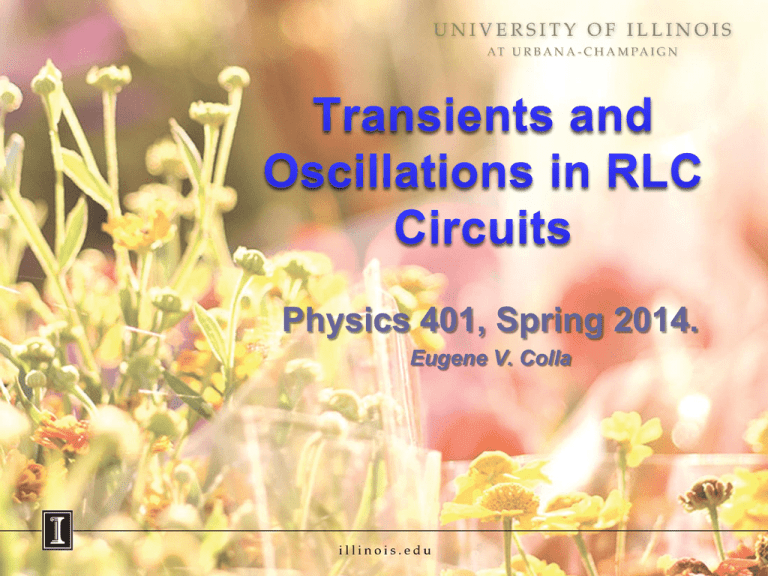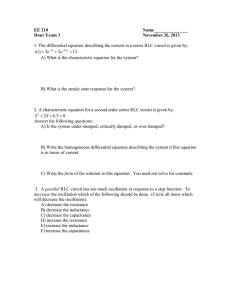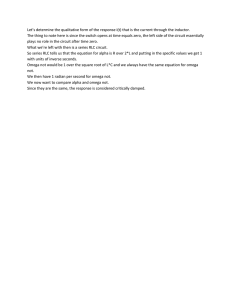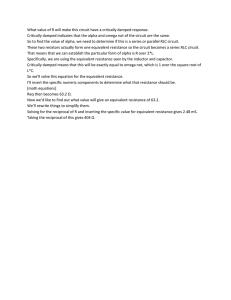Transients and Oscillations in RLC Circuits
advertisement

Physics 401, Spring 2014. Eugene V. Colla Transients and Oscillations in RLC Circuits. Outline Main goals of this week Lab: Transients. Definition. transient ( physics ) a short-lived oscillation in a system caused by a sudden change of voltage or current or load a transient response or natural response is the response of a system to a change from equilibrium. System under study Transients in RLC circuit. Resistance R [Ohm] Capacitance C [uF] (10-6F) Inductance L [mH] (10-3H) R L scope V C Transients in RLC circuit. According the Kirchhoff’s law * VR+VL+VC=V(t) d2 d q(t) L 2 q(t) + R q(t) + =0 dt dt C (1) *See Lab write-up for details R L VL 1.0 scope V(t) V0 V(t) VR 0.5 C VC 0.0 -1.0 -0.5 0.0 time 0.5 1.0 Transients in RLC circuit. Three solutions The solution of this differential equation can be found in the form This will convert (1) in quadratic equation s1,2 with solutions: a R s L 2 q (t ) A est 1 0 s LC 2 R R 1 a b 2L 2L LC 2 R R 1 , b 2L 2 L LC b2>0 over-damped solution b2=0 critically damped solution b2<0 under-damped solution Transients in RLC circuit. Over-damped solution: b2>0 In this case the solution will be aperiodic exponential decay function with no oscillations: i (t ) q (t ) e at A1e bt B1e bt dq ae at ( A1e bt B1e bt ) be at ( A1e bt B 1e bt ) dt Transients in RLC circuit. Over-damped solution: b2>0 Taken in account the initial conditions: q(0)=q0 and i(0)=0 q (t ) q 0e at ( a -b )t 1 a cosh bt sinh bt b q0 a -(a -b )t 1 e 2 b q 0 a 2 b 2 (a b )t i (t ) e 2 b This is exponential decay function Transients in RLC circuit. Critically-damped solution b2=0 For this case the general solution can be found as q(t)=(A2+B2t)e-at. Applying the same initial condition the current can be written as i=–a2q0te-at 4L b 0 R C 2 2 and R a 2L Critically-damped conditions for our network Critical damped case shows the fastest decay with no oscillations Transients in RLC circuit. Critically-damped solution. Real data analysis. 2 b =0 In this experiment R=300 ohms, C=1mF, L=33.43mH. The output resistance of Wavetek is 50 ohms and resistance of coil was measured as 8.7 ohms, so actual resistance of the network is Ra=300+50+8.7=358.7 Decay coefficient 𝒂= 𝑹 𝟑𝟓𝟖.𝟕 = 𝟐𝑳 𝟐∗𝟑𝟑.𝟒𝟑𝑬−𝟑 ≈ 𝟓𝟑𝟔𝟓 Transients in RLC circuit. Critically-damped solution. Real data analysis. b2=0 Vc ~q, fiiting function: Vc=Vco(1+at)e-at Now the experimental results: Calculated decay coefficient ~5385, Obtained from fitting ~5820. Possible reason – it is still slightly over damped Calculated b2 is b2=2.99e7-2.90e7>0 Transients in RLC circuit. Under-damped solution. If b2<0 we will have oscillating solution. Omitting the details (see Lab write-up) we have the equations for charge and current as: a a q(t) q 0e at cos bt sin bt q 0e at 1 2 sin(bt ) b b 2 2 at a b i(t) q 0e sin bt b 2 2 R R 1 a , b 2L 2L LC 1 ; f 2 1 LC R 2L 2 Transients in RLC circuit. Under-damped solution. Log decrement. Quality factor. Log decrement can be defined as 𝜹 = 𝒍𝒏 6 Quality factor can be 𝑬 defined as 𝑸 = 𝟐𝝅 , ∆𝑬 For RLC 𝑸= = = 𝒂𝑻𝟏 , where T1=1/f1 𝝎𝟏 𝑳 𝑹 = 𝝅 𝜹 From this plot d≈0.67 Q≈4.7 VC (q/C) (V) 𝒍𝒏 𝒆−𝒂𝒕𝒎𝒂𝒙 𝒆−𝒂𝒕𝒎𝒂𝒙 +𝑻𝟏 𝒒(𝒕𝒎𝒂𝒙 𝒒(𝒕𝒎𝒂𝒙 +𝑻𝟏 3.529 3 1.809 0.92962 0.47494 0 -3 -6 -1 0 1 2 3 4 5 6 7 time (ms) 8 9 10 Transients in RLC circuit. Data analysis. Using Origin software. VC (q/C) (V) 6 0.00115 3 0.0023 0.00346 0.00463 0 f=862Hz -3 -6 -1 0 1 2 3 4 5 6 7 8 9 10 9 10 time (ms) VC (q/C) (V) 6 3 0 f=862Hz -3 -6 -1 0 1 2 3 4 5 6 7 time (ms) 8 1. 2. 3. 4. Pick peaks Envelope Exponential term Nonlinear fitting Transients in RLC circuit. Under-damped solution. Log decrement. Quality factor. Transients in RLC circuit. Data analysis. Log decrement. Using Origin software. Results. Time domain trace Points found using “Find peaks” Envelope curve Transients in RLC circuit. Data analysis. Log decrement. Using Origin software. Results. Fitting the “envelope data” to exponential decay function Transients in RLC circuit. Data analysis. (1/T)2 vs 1/C experiment. q(t) Ae at s in(t ) offset 0ffset Manual evaluation of the period of the oscillations Limited accuracy Results can be effected by DC offset Zero crossing points Transients in RLC circuit. Data analysis. (1/T)2 vs 1/C experiment. Using Origin software. q(t) Ae at s in(t ) Use Origin standard function Category: Limited Waveform Function: SineDamp Fitting function ; y0,A,t0 xc, w – fitting parameters Transients in RLC circuit. Data analysis. (1/T)2 vs 1/C experiment. Using Origin software. q(t) Ae at s in(t ) Limited Data plot + fitting curve Residuals - criteria of quality of fitting Transients in RLC circuit. Data analysis. (1/T)2 vs 1/C experiment. Using Origin software. q(t) Ae at s in(t ) f 2 2 1 1 1 T 2 LC Final results R 2L 2 Resonance in RLC circuit. 1904.83204 14 R2 12 f=1500Hz VC UC C V(t) 10 L 8 6 4 2 0 𝑸= 𝒇 𝟏𝟗𝟎𝟒 = 𝜟𝒇 𝟏𝟓𝟎𝟎 = 𝟏. 𝟐𝟔 100 1000 f (Hz) 10000 Origin templates for this week Lab. \\engr-file-03\phyinst\APL Courses\PHYCS401\Common\Origin templates Open template button Origin manuals \\engr-file-03\phyinst\APL Courses\PHYCS401\Common\Origin manuals Very short and simple manual which covers only main general operations with Origin. Document located on server and there is a link from P401 WEB page There are also manuals from OriginLab. Do not forget about Origin Help Video Tutorials at the site of the company http://www.originlab.com/index.aspx?go=SUPPORT/VideoTutorials


